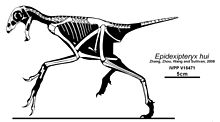Epidexipteryx
| Epidexipteryx | |
|---|---|

| |
| Holotype fossil exhibited in Japan | |
| Scientific classification | |
| Domain: | Eukaryota |
| Kingdom: | Animalia |
| Phylum: | Chordata |
| Clade: | Dinosauria |
| Clade: | Saurischia |
| Clade: | Theropoda |
| Family: | †Scansoriopterygidae |
| Genus: | †Epidexipteryx Zhang et al., 2008 |
| Species: | †E. hui
|
| Binomial name | |
| †Epidexipteryx hui Zhang et al., 2008
| |
Epidexipteryx is a genus of small paravian dinosaurs, known from one fossil specimen in the collection of the Institute of Vertebrate Paleontology and Paleoanthropology in Beijing. Epidexipteryx represents the earliest known example of ornamental feathers in the fossil record.[1]
Discovery

The type specimen, belonging to a subadult individual, is catalog number IVPP V 15471.[2] The specific name, Epidexipteryx hui ("Hu's display feather"), and its Chinese name Húshì Yàolóng ("Hu Yaoming's display dragon") were coined in memory of paleomammologist Hu Yaoming.[3]
Due to a pre-publication error,[4] a manuscript of the Epidexipteryx hui description first appeared on a preprint Web portal in late September 2008. The paper was officially published in the October 23, 2008 issue of the journal Nature.[2]
Description
E. hui is known from a well-preserved partial skeleton that includes four long feathers on the tail, composed of a central
In all, the skeleton of Epidexipteryx hui measures 25 cm (9.8 in) in length (44.5 cm (17.5 in) including the incomplete tail feathers),[6] and the authors estimated a weight of 164 grams, smaller than most other basal avialans.[2] Gregory S. Paul presented a length estimate of 30 cm (12 in) and body mass estimate of 220 g (0.49 lb).[7]

The skull of Epidexipteryx is also unique in a number of features, and bears an overall similarity to the skull of
Classification
The exact phylogenetic position of Epidexipteryx within Paraves is uncertain. The phylogenetic analysis conducted by the authors of its description recovered it as a member of the family Scansoriopterygidae and as a basal member of the clade Avialae;[2] this was confirmed by the subsequent analysis conducted by Hu et al. (2009).[8] A later analysis conducted by Agnolín and Novas (2011) confirmed it to be a scansoriopterygid, but recovered a different phylogenetic position of this family: Scansoriopterygidae was recovered in polytomy with the family Alvarezsauridae and the clade Eumaniraptora (containing the clades Avialae and Deinonychosauria).[9] Turner, Makovicky and Norell (2012) included Epidexipteryx but not Scansoriopteryx/Epidendrosaurus in their primary phylogenetic analysis, as a full-grown specimen is known only of the former taxon; regarding Scansoriopteryx/Epidendrosaurus, the authors were worried that including it in the primary analysis would be problematic, because it is only known from juvenile specimens, which "do not necessarily preserve all the adult morphology needed to accurately place a taxon phylogenetically" (Turner, Makovicky and Norell 2012, p. 89). Epidexipteryx was recovered as basal paravian that didn't belong to Eumaniraptora. The authors did note that its phylogenetic position is unstable; constraining Epidexipteryx hui as a basal avialan required two additional steps compared to the most parsimonious solution, while constraining it as a basal member of Oviraptorosauria required only one additional step.
Cau (2024) cast doubt on the validity of Epidexipteryx, considering it a

A separate exploratory analysis included Scansoriopteryx/Epidendrosaurus, which was recovered as a basal member of Avialae; the authors noted that it did not clade with Epidexipteryx, which stayed outside Eumaniraptora. Constraining the monophyly of Scansoriopterygidae required four additional steps and moved Epidexipteryx into Avialae.[11] A monophyletic Scansoriopterygidae was recovered by Godefroit et al. (2013); the authors found scansoriopterygids to be basalmost members of Paraves and the sister group to the clade containing Avialae and Deinonychosauria.[12] Agnolín and Novas (2013) recovered monophyletic Scansoriopterygidae as well, but found them to be non-paravian maniraptorans and the sister group to Oviraptorosauria.[13]
An abbreviated version of Zhang et al.'s 2008 cladogram is presented below.
| Maniraptora |
| |||||||||||||||||||||||||||||||||
Paleobiology
Epidexipteryx appears to have lacked
Paleoenvironment
Epidexipteryx is known from the
References
- ^ Morgan, James (2008-10-22). "New feathered dinosaur discovered". BBC. Retrieved 2009-07-02.
- ^ S2CID 4362560. Archived from the original(PDF) on 2015-05-24. Retrieved 2015-05-24.
- ^ "Chinese scientists discovers new dinosaur species". People's Daily Online. October 27, 2008. Archived from the original on February 2, 2009. Retrieved November 4, 2008.
- ^ Dr. Thomas Holtz, Jr. "The mistaken scansoripterygid". Message to the Dinosaur Mailing List <http://dml.cmnh.org/2008Oct/msg00008.html Archived 2016-03-03 at the Wayback Machine> (October 1, 2008)
- ^ "Epidexipteryx: Bizarre little strap-feathered maniraptoran : Tetrapod Zoology". Archived from the original on 2011-06-06. Retrieved 2010-12-10.
- S2CID 4362560.
- OCLC 985402380.
- S2CID 205218015.
- PMID 21437379.
- .
- S2CID 83572446.
- PMID 23340434.
- S2CID 199493087.
- ^ Cau, A (2012), Il ritorno del paraviano pterosauro-mimo?, Theropoda, July 2012
